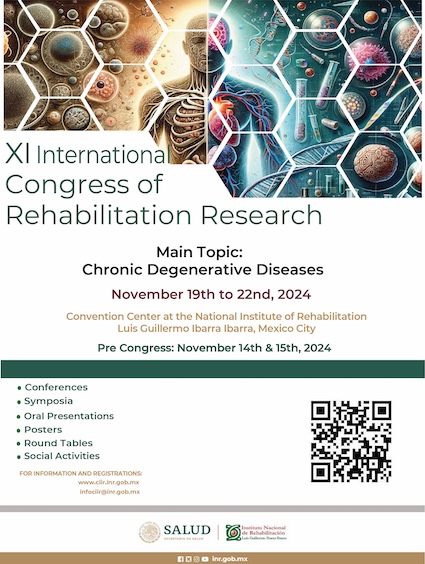Linguistic alterations in children with and without ADHD by clinical subtype evaluated with the BLOC-S-R test
DOI:
https://doi.org/10.35366/112696Keywords:
linguistic disturbances, attention deficit hyperactivity disorder,, schoolchildrenAbstract
Introduction: acquisition and development of language are complex processes that rely on the
chronological development of the child, as well as environmental and social factors. The American
Speech-Language-Hearing Association (ASHA) defines the term «language disorder» as the «impaired
comprehension and/or use of spoken, written, and/or other symbol systems, including morphology,
syntax, semantics, and pragmatics». Objective: to compare the speech alterations in children with
ADHD by clinical subtype against healthy children with the BLOC-S-R test. Material and methods:
the design was observational comparative cross-sectional study. A sample of 156 schoolchildren
with ADHD and 111 schoolchildren without ADHD, aged between 7 and 12 years old, from seven
public educational institutions, was studied. Prior authorization from the school administrators and
signed informed consent from their parents were obtained. A screening test based on the DSM-V
was applied to teachers and parents, and those children suspected of having ADHD were further
confirmed through neuropsychology, child psychiatry, and psychology services. A group without
ADHD was formed with the schoolchildren who were found to not have the condition and met the
inclusion criteria. All participants underwent the BLOC-S-R test, and the results were analyzed using
SPSS v. 19 software, applying descriptive statistics and χ2 for comparisons. Results: a total of 267
schoolchildren were studied, of whom 156 were identified as having ADHD and 111 without ADHD.
The diagnosed subtypes were 73 (27%) with the combined subtype, 39 (15%) with the inattentive
subtype, and 44 (17%) with the hyperactive-impulsive subtype. Out of these, 186 were male and 81
were female, with an average age of 8.2 ± 1.7. Linguistic skills in morphology, syntax, and semantics
showed a «T» level of low proficiency, and pragmatics showed an «E» level of very low proficiency in
the ADHD group compared to the group without ADHD, who obtained an «S» level of proficiency in
all skills. Significant differences were found in all four linguistic skills. Conclusions: school children
with ADHD present a greater alteration in the pragmatic language skill, followed by syntax. The
scores on linguistic skills of schoolchildren with ADHD evaluated with the BLOC-S-R test are lower
compared to the group without ADHD.
References
Rodillo BE. Trastorno por déficit de atención e
hiperactividad (TDAH) en adolescentes. Rev Med Clin
Condes. 2015; 26 (1) 52-59.
Medici D, Morales SVM. Lenguaje y rendimiento escolar
en el niño con diagnóstico en trastorno por déficit de
atención/hiperactividad (TDAH). Rev Mex Neuroci.
; 18 (1): 89-99.
American Psychiatric Association. DSM-V Diagnostic
and statistical manual of mental disorders. 4th edition.
In: Revised text. Barcelona: Masson; 2013.
Llanos Lizcano LJ, García Ruiz DJ, González Torres
HJ, Puentes Rozo P. Trastorno por déficit de atención
e hiperactividad (TDAH) en niños escolarizados de 6
a 17 años. Rev Pediatr Aten Primaria. 2019; 21 (83):
e101-e108.
Gaitán Chipatecua A, Rey-Anacona CA. Diferencias
en funciones ejecutivas en escolares normales, con
trastorno por déficit de atención e hiperactividad,
trastorno del cálculo y condición comórbida. Av Psicol
Latinoam. 2013; 31 (1): 71-85.
Willcutt EG, Petrill SA, Wu S, Boada R, Defries JC, Olson
RK et al. Comorbidity between reading disability and
math disability: concurrent psychopathology, functional
impairment, and neuropsychological functioning. J Learn
Disabil. 2013; 46 (6): 500-516.
Giraldo Giraldo Y, Chaves Castaño L. Trastorno por
déficit de atención/hiperactividad (TDAH) y dificultades
en lenguaje pragmático. Rev Psicol Univ Antioquia.
; 6 (1): 25-40.
Trujillo Orrego N, Pineda D, Uribe LH. Validez del
diagnóstico de trastorno por déficit de atención/
hiperactividad: de lo fenomenológico a lo neurobiológico
(I). Rev Neurol. 2012; 54 (5): 289-302.
Abad M, Uriel D. Evaluación del lenguaje oral por
medio del BLOC en alumnos de quinto de primaria con
lenguas maternas de orígenes diversos. En: Puyuelo M
(Ed.). BLOC. Aplicación a poblaciones con necesidades
educativas específicas. Barcelona: Elsevier Masson;
pp. 165-208.
Skogli EW, Teicher MH, Andersen PN, Hovik KT, Oie
M. ADHD in girls and boys--gender differences in co-
existing symptoms and executive function measures.
BMC Psychiatry. 2013; 13: 298. doi: 10.1186/1471-
X-13-298.
Flapper BC. Schoemarker M. Developmental
coordination disorder in children with specific language
impact on quality of life. Res Dev Disabil 2013; 34 (2):
-63.
Moraleda Sepúlveda E. Perfil lingüístico en niños y
adolescentes con trastorno por déficit de atención e
hiperactividad (TDAH). Revista INFAD de Psicología.
; 1 (2): 151-158.
Puyuelo M, Renom J, Solana A, Wiig E. Evaluación del
lenguaje (BLOC-C/BLOC-S/BLOC-SR). Aplicación a
poblaciones con necesidades educativas especiales.
Barcelona: Elsevier Masson; 2007.
Maurens MN, Olivares F, Vergara V. Habilidades
psicolingüísticas en escolares de entre 6 años y 9
años 11 meses con trastorno por déficit atencional e
hiperactividad. Santiago, Chile: Universidad de Chile;
Paredes P. Mpreno-García I. Competencias Lingüísticas
en el contexto escolar. Revista Española de Pedagogía
; 79 (280): 497-514. Disponible en: https//www.
jstor,org.
Elías Lillo J, Crespo Allende N, Góngora Costa B. El
desempeño sintáctico de niños con trastorno de déficit
atencional e hiperactividad: perspectiva comparativa y
ontogenética. RLA. 2012; 50 (1): 95-117.
Downloads
Published
How to Cite
Issue
Section
License
Copyright (c) 2023 Instituto Nacional de Rehabilitación Luis Guillermo Ibarra Ibarra

This work is licensed under a Creative Commons Attribution 4.0 International License.
© Instituto Nacional de Rehabilitación Luis Guillermo Ibarra Ibarra under a Creative Commons Attribution 4.0 International (CC BY 4.0) license which allows to reproduce and modify the content if appropiate recognition to the original source is given.




